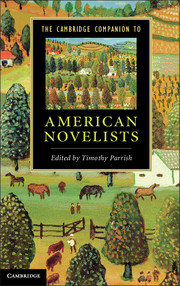Book contents
- Frontmatter
- Contents
- Contributors
- Introduction
- 1 James Fenimore Cooper
- 2 Nathaniel Hawthorne
- 3 Herman Melville
- 4 Harriet Beecher Stowe
- 5 Mark Twain
- 6 Henry James
- 7 Edith Wharton
- 8 Theodore Dreiser
- 9 Willa Cather
- 10 F. Scott Fitzgerald
- 11 Ernest Hemingway
- 12 William Faulkner
- 13 Henry Roth
- 14 Djuna Barnes
- 15 Zora Neale Hurston
- 16 Richard Wright
- 17 Raymond Chandler
- 18 Ralph Ellison
- 19 J. D. Salinger
- 20 Patricia Highsmith
- 21 Vladimir Nabokov
- 22 Jack Kerouac
- 23 Saul Bellow
- 24 Kurt Vonnegut
- 25 John Updike
- 26 Thomas Pynchon
- 27 Toni Morrison
- 28 Philip Roth
- 29 Don DeLillo
- 30 Cormac McCarthy
- Guide to Further Reading
- Index
- References
2 - Nathaniel Hawthorne
Published online by Cambridge University Press: 05 December 2012
- Frontmatter
- Contents
- Contributors
- Introduction
- 1 James Fenimore Cooper
- 2 Nathaniel Hawthorne
- 3 Herman Melville
- 4 Harriet Beecher Stowe
- 5 Mark Twain
- 6 Henry James
- 7 Edith Wharton
- 8 Theodore Dreiser
- 9 Willa Cather
- 10 F. Scott Fitzgerald
- 11 Ernest Hemingway
- 12 William Faulkner
- 13 Henry Roth
- 14 Djuna Barnes
- 15 Zora Neale Hurston
- 16 Richard Wright
- 17 Raymond Chandler
- 18 Ralph Ellison
- 19 J. D. Salinger
- 20 Patricia Highsmith
- 21 Vladimir Nabokov
- 22 Jack Kerouac
- 23 Saul Bellow
- 24 Kurt Vonnegut
- 25 John Updike
- 26 Thomas Pynchon
- 27 Toni Morrison
- 28 Philip Roth
- 29 Don DeLillo
- 30 Cormac McCarthy
- Guide to Further Reading
- Index
- References
Summary
Nathaniel Hawthorne (1804–64) is at the very center of the American novel tradition, not only because so many students read The Scarlet Letter (1850) in high school or college, but also because the issues the book raises – sex and religion, liberation versus repression, gender and the position of women, the nature of the human personality and the prospects for remaking the social order – are enduringly part of American culture. Hawthorne’s special insight, like Faulkner’s, is his understanding of how individuals are at once timeless in their basic impulses and inflected by and enmeshed in history, often tragically. We must read him with something of this same understanding. Hawthorne is different from us, a man of the mid–nineteenth century even when he writes of the mid–seventeenth, and he is also like us, addressing versions of the conflict between the “I want” and the “thou shalt” (social, moral, religious, psychological) that besets people in all ages and cultures.
Hawthorne came to the novel late, at forty-five, in what might be called the third phase of his career. The first phase was the period of near-seclusion he spent mainly in his family house in Salem between his graduation from Bowdoin College in 1825 and the publication of Twice-Told Tales in 1837, years in which he wrote and anonymously published many of his best and nearly all of his darkest tales. The second phase began with his marriage to Sophia Peabody in July 1842 and their settling at the Old Manse in transcendental Concord, and it extended through the fall of 1845 when a combination of events returned Hawthorne to Salem and presently installed him as surveyor of customs in the Salem Custom House.
- Type
- Chapter
- Information
- The Cambridge Companion to American Novelists , pp. 11 - 21Publisher: Cambridge University PressPrint publication year: 2012



